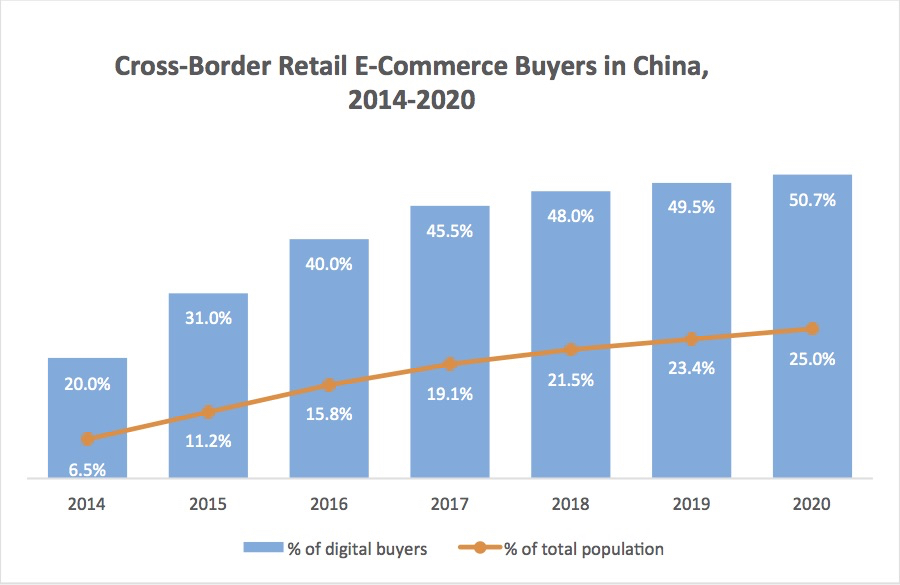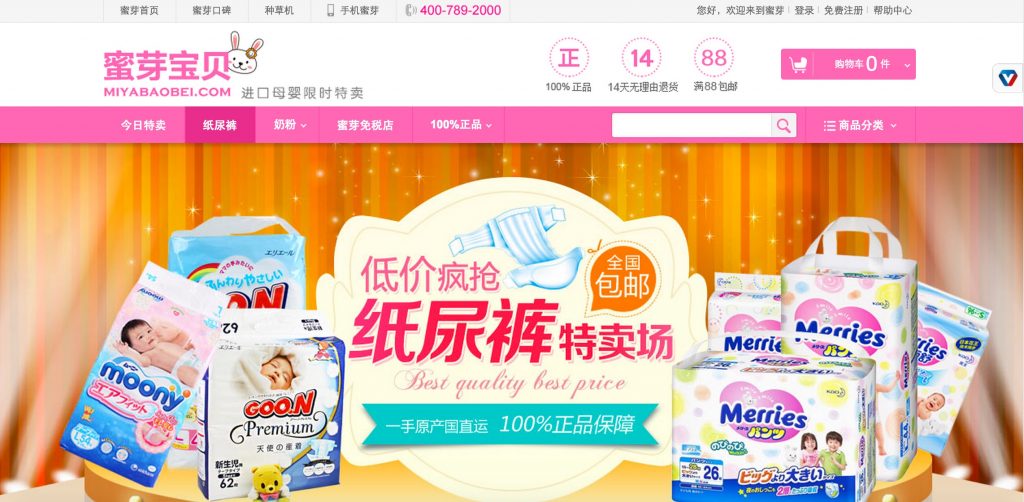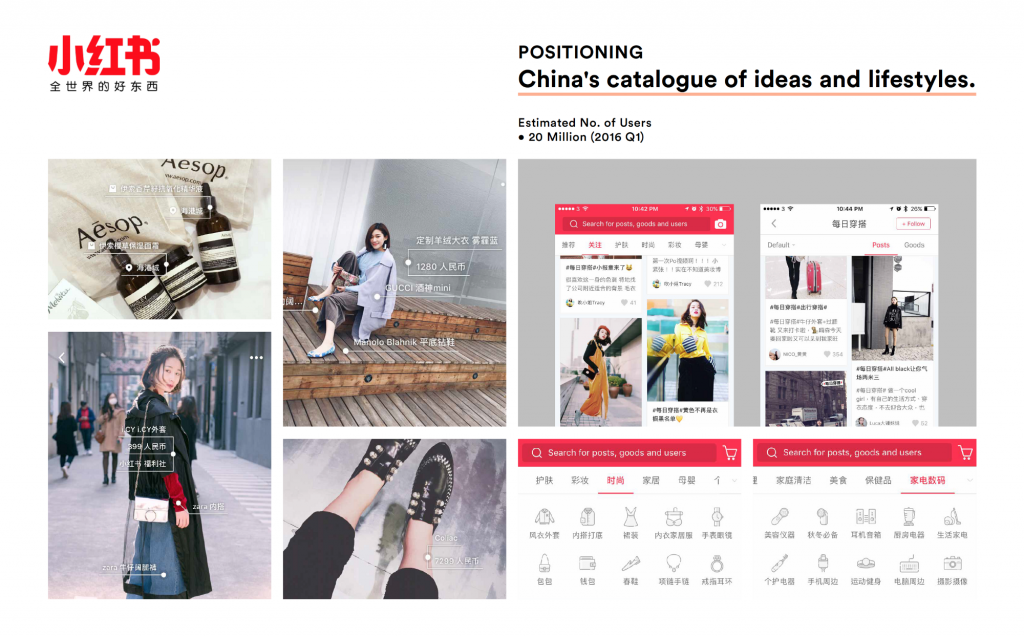What is Cross-Border E-Commerce
Cross Border E-Commerce is the buying and selling of overseas products through e-commerce platforms. Any user involved in the e-commerce industry recognises the potential that China holds. With increasing disposable incomes and greater knowledge of foreign products and product quality, the China cross-border e-commerce market is expected to grow significantly.
- Cross-border e-commerce reached 6.5 trillian yuan in 2016, accounting for nearly 20% of all of China’s foreign trade.
- This number is projected to grow at 30% annually in the next few years. With 41 million cross-border shoppers in 2016, this means that by the end of 2018, there should be well over 70 million consumers shopping via cross-border e-commerce.
Who are these Cross-Border Shoppers?
The China E-Commerce Research center found that the majority of shoppers are relatively young with the largest group being around 30 years old, with the largest portion of them being male (62.6%).
- A survey reports that over 15% of the Chinese population had cross-border shopped.
- The average spend was $473 per purchase.
As the E-commerce market in China is predicted to double in the next 5 years, there will be a significant opportunity for cross-border e-retailers in China. In light of the large opportunity, where and what should businesses be focusing on?
Where to target, and the most popular product types?
The top markets for cross-border e-commerce were naturally in the larger cities.
- The top 5 cities were Shanghai, Beijing, Hangzhou, Guangzhou, and Shenzhen.
- Growth was also present in smaller cities, however, with 31% of new customers coming from 3rd or 4th tier cities.
The top 5 countries exporting to China through Cross-Border E-Commerce were Japan, the USA, South Korea, Germany and Australia.
- Whereas Japanese and Korean exports were made up of mostly cosmetics and serums, Western countries were more popular for their baby products, food, and vitamins/supplements.
- Out of all the product types, cosmetics and baby products were consistently the most popular. The reason for this would likely be that domestic variations were of lower quality, while still at a similar price.
Legalities regarding Cross-Border E-Commerce
‘Bonded warehouses’ were facilities that allowed for storing overseas goods brought in by bulk ship merchants, without needing to be subject to strict quality control measures or commercial import duties; this was a pivotal point in the rapid boom of Cross-Border E-Commerce.
A few years ago however, officials signaled that the legislation allowing for this warehousing system was to be changed, causing a scare among merchants. Despite the worry however, the government decided to allow the practice to continue for the near future, albeit with an increased import tax.
As of now this method of selling into China is still completely legal and is the preferred method of many brands in China. While the government may change this policy, it is unlikely that they would change policy in a way that would deal significant financial damage to companies operating under this system.
China Cross Border E-Commerce: Which Platforms to Use
1. Kaola.com – The largest player in China’s Cross-Border E-Commerce Market
Kaola is owned by Netease, and was originally envisioned to be a platform for selling Australian products in China. NetEase spokeswoman Maggie Liu said the koala was chosen as a symbol because, like the marsupial, NetEase wants its online customers to be “lazy and comfortable while it does all the hard work of delivering the best foreign products to people’s doors.”
Originally focused on Australia, E-retailers from over 40 countries now sell their products through the Kaola platform. With its other resources in news and gaming, the company has been able to drive more users onto the platform and build trust in in the platform.
Users can purchase anything from diapers and baby formula to rock lobsters on the platform. It is leading the pack in terms of Cross Border E-Commerce due to its accessibility and variety of uses. Retailers who depend heavily on portraying the quality of their product and the inherent benefit of being “foreign” should consider Kaola when beginning to sell in China
2. MiYaBaoBei – A website dedicated to providing quality foreign baby products
Miyabaobei is an e-commerce platform that focuses primarily on overseas products made for infant care. Popular products on the platform include baby formula, clothing, toys, and all other types of products for babies. Originally beginning as a storefront on Taobao, it was given its own website and mobile app once its level of sales became adequate. Nearly 75% of its sales are made through its mobile app.
Demand for imported baby products has been caused by massive scandals in domestic industries, such as the incident in 2008, in which melamine-tainted milk was sold by one of China’s largest baby formula producers. Stemming from this, Miyabaobei has seen consistent year on year growth in sales due to its ability to provide quality baby products to families in China.
3. XiaoHongShu (Little Red Book) – The new player in cosmetics and beauty products taking China’s Cross-Border E-Commerce Market by storm
XiaoHongShu is a relatively new platform launched in January 2014, with a user base of over 25 million. The site is both a social media platform and an e-commerce platform, and allows users to post pictures of their favorite products and in turn, buy them directly through the platform.
The platform’s target audience is women aged 18-30, with it’s most popular products being cosmetics and beauty products. While it has formed strategic partnerships with many large cosmetic brands, it is also quite accessible to smaller brands hoping to expand to China.
Aside from its e-commerce functionality the site aims to educate users on how to shop when traveling abroad. Popular user-generated content includes guides on how to shop while traveling abroad, and videos of travelers documenting their shopping experiences abroad.
4. Yangmatou – The First Mover in China Cross-Border E-Commerce
Yangmatou was launched in 2009 and still boasts considerable market share for China cross-border e-commerce. Yangmatou offers a variety of products, but focuses primarily on the popular product categories for cross-border e-commerce. These products include baby products, beauty products, nutrition products, clothes, shoes, and handbags.
Yangmatou relies heavily on Chinese interest in foreign products to sell goods. It includes flags of the country where a product was produced with every product listing. Yangmatou’s product descriptions are also very detailed, which helps to prove to consumers that products are genuine.
The site claims to have over 10,000 daily orders and over 1 million users, and partnered with Paypal recently to allow for easier transactions with foreign brands across the world.












